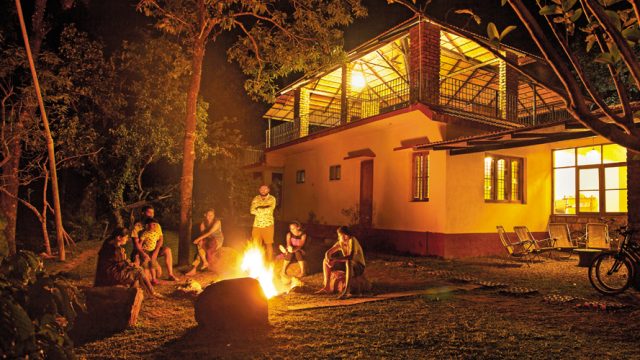Few things beat waking up to the aroma of hot filter coffee on a bleary morning. How about waking up to hot filter coffee on a serene coffee estate, the only sound in the air being birdsong, and the hushed whispers of tall trees? If you’re a nature lover and coffee aficionado, a homestay bang in the middle of a coffee estate is the perfect weekend getaway.
This is what I signed up for—a day-long respite from the urban chaos and a walkthrough of the coffee-bean making process in Sakleshpur, Karnataka. When I was first driven through the dense Harley estate, established in 1864, I was reminded of the many wildlife safaris I’d taken. My skilled driver and guide happened to be the head of the estate, Chandni D.M. Director of Marketing and Administration, Classic Group, Chandni is part of the fifth generation of coffee planters in her family.

An off-road racer in her spare time, Chandni knows the pulse of every plantation like the gears on her ride. Given the altitude (3,100 ft) of the region, a third of the plants here are Arabica and the rest Robusta, beautifully interspersed with elderly forest trees. Other plantations include areca, pepper, cocoa, and cardamom. Coffee absorbs the flavours of its neighbouring plantations, making each batch of produce taste unique. Only wine can claim to have as much character, in my book.

But coffee has been dealt a body blow by climate change. These plants bloom just two days in a year, ideally during the first showers in April. That’s the time when tiny white flowers blanket the 550-acre estate and impregnate the air with a tantalising fragrance. Arabica is harvested during December-January and Robusta from December to March, which makes these months ideal for coffee tourism. For the last few years, however, rainfall has been scanty and untimely. So estates in the area have been using sprinklers to simulate rain and induce blooming on time.
After a brief tour, we headed to a plantation that was being harvested. Local women picked coffee berries—the hues ranging from red to deep purple—off mature Robusta plants, some of them 80 years old. I dug into a berry and found a soft, sweet pulp ensconcing a pair of green beans inside. A rat snake slithered by our berry baskets, flummoxed by the abundance of footsteps on the forest floor.
The berry picking was followed by a quick lunch at the homestay. Set up two years ago by Chandni, Golden Wood has eight distinct rooms on offer. The food served is authentic Malnad cuisine and the rooms are devoid of wi-fi, TV, and other distractions. Even my cell phone failed to catch a signal during my stay.

I stayed in a quaint, bare-brick cottage that featured a tree in the middle of the bath. Everything about this renovated planter’s residence screamed organic. Bamboo had been used abundantly—to make lampshades, a wardrobe stand and wall hangings. There’s also a mudhouse—with a poetic room in the attic—that provides a rustic experience replete with copper vessels, red oxide floor, bed legs made out of old coffee stems, and hosts draped in traditional costumes. Two hilltop rooms, Tusker and Antler, are more conventionally built. The most modern structure—Whispering Trees—erected in a clearing amidst tall, rustling trees includes three rooms, a lounge and a kitchen. Its rooftop is the ideal place to watch any of the 200 species of birds found in this region.

As much as I would have loved to take an afternoon nap on one of the inviting hammocks, we moved on to the next stage of the process. The berries go to a pulper the size of a cottage. It separates the good berries from the inferior ones, peels their skin off to reveal the beans, ferments them for 36 hours, and washes them, after which they’re dried in the sun for delivery. (Unwashed beans acquire some of the pulp’s sweetness and are sold separately as pulp sun-dried coffee, aka honey coffee.)
While the estate’s job with the beans is done at this point, my experience didn’t end there. The final cup of coffee still eluded me. I was then taken to a lab that brewed coffee using three distinct processes—Chemex, French Press and Aeropress. The gustatory nuances of the three cups were hard to miss, harder to articulate. A cupping session of freshly ground and roasted beans then introduced me to the refined art of coffee tasting.

The nippy evening wind was met with a crackling bonfire. With a mug of coffee cupped between my now reverential hands, Chandni and I indulged in a chat on favourite books and authors. It soon morphed into an introspective debate on the agony of existentialism. A day in a forest can do strange things to the mind. Thank God for coffee!
The Information
Location: Harley Estate, Sakleshpur, Karnataka. It’s a 3-hour drive from Bengaluru.
Accommodation: 8 rooms, including a bare-brick cottage and 2 rooms in the mudhouse
Tariff: On weekdays, a room in Whispering Trees or Hilltop Courtyard costs ₹5,500; the bare-brick cottage and the Farmer’s Mudhouse cost ₹6,300 per day, including all meals and the estate tour. Rates higher on weekends.
Contact: +91-9902297022, goldenwood.in




